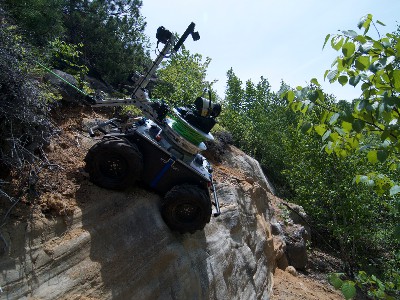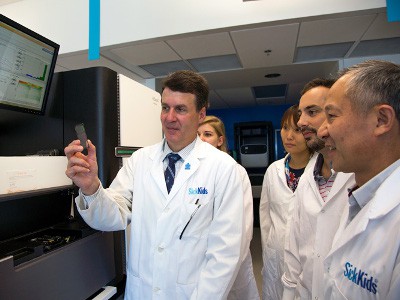Researchers test robot vehicles in harsh terrain of an Ontario gravel pit


A team of University of Toronto researchers put several robot vehicles through their paces for two weeks this past June on a five kilometre network of interconnected paths at an old sand and gravel pit in Sudbury, Ontario, as part of the Natural Sciences and Engineering Research Council of Canada (NSERC)’s Canadian Field Robotics Network.
Three robots were used, including a Grizzly large all-terrain robotic utility vehicle made by Waterloo, Ontario’s Clearpath Robotics, which was driven 120 kilometres by the research team, using a stereo visual teach and repeat (VT&R) algorithm that they developed.
The other robots used were the plane-like Lancaster fixed-wing UAV, which made several aerial surveys of the pit, and the Tethered Robotic Explorer (TReX) climbing robot, designed by University of Toronto researchers, which descended down several steep rocks and terrain in order to help build 3D models.
The field trials consisted of three main experiments:
- A Visual Teach and Repeat (VT&R) approach to vision-only route following
- Aerial surveys of the site using fixed-wing unmanned aerial vehicles
- A tethered robot design for mapping steep surfaces such as cliffs
“Imagine a robot finding its way down a long canyon and then realizing it is a dead-end; because it has saved the outbound route, it can backtrack along it using VT&R and then try something else,” writes Dr. Barfoot on his UofT page. “VT&R has been successful because it avoids the need to construct a visual map of the world in a single priviledged coordinate frame and instead utilizes a topometric map.”
The VT&R experiments are more advanced versions, dubbed VT&R 2.0, of previous work conducted by the team, this time adding a Multi-Experience Localization (MEL) technique, which matches live images to repeated experience of the path and so makes the robot’s reactions more sensitive to change.
The new VT&R 2.0 approach also added an ability to perform place-dependent terrain assessment for safeguarding both the robot and the people around it, regardless of how rough the terrain and its vegetation.
The robots were taught how to negotiate the five kilometre path, and were then released to autonomously repeat those paths for 120 kilometres using only their on-board stereo vision for feedback.
The research is associated with two papers co-authored by University of Toronto Institute for Aerospace Studies professor Dr. Timothy Barfoot, whose lab intends to enable field robotics applications by advancing visual navigation for mobile robots.

Terry Dawes
Writer


